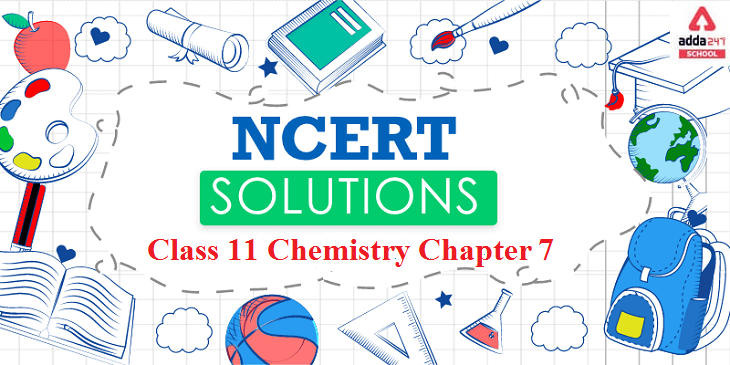Ncert Solutions For Class 11 Chemistry Chapter 7 Equilibrium
Adda247 provides NCERT solutions for class 11 chemistry chapter 7. The NCERT Solutions class 11 chemistry chapter 7 provided here will enhance the concepts of the students, as well as suggest alternative methods to solve particular problems to the teachers.
These NCERT Solutions Class 11 chemistry are presented in a very simple language so that you can understand the basic of chemistry with ease. These NCERT Solutions class 11 Chemistry cover chapters 1 to 14 with all important questions and answers explained in a detailed way.
Students can download the Class 111 Chemistry NCERT Solutions, which they want to study with the comfort of their house.
The solutions available are in depth and simplest way. Thus will help the students beyond examination marks. This will help them develop a core understanding of the subject. Because this subject demands to understand rather than just memorizing solutions of Class 11 Chemistry. Here below we are providing you with the overview of all the chemistry Class 11 Chapters that are there in the NCERT textbook.
At Adda247, students can access chapter wise solutions to get their doubts clarified instantly. The faculty had provided both online and offline mode of Solutions which can be used free of cost.
Benefits of Solutions of NCERT class 11 Chemistry:
- NCERT Solutions for Class 11 is helpful to solve questions from other reference books too.
- NCERT Solutions for class 11 Chemistry will assist students to cross check answers and prepare for the exams in a strategic way.
The students can access the solutions anywhere while browsing web easily. The solutions are very precise and accurate.
NCERT Solutions for Class 11 Chemistry Chapter – 7: Equilibrium
Chemistry is the basic of things which we see around in our environment and is known as the “central science”. As chemistry is a mandatory subject for the students, it requires more focus from the exam perspective. The solutions provided here are equipped with all the basic details with questions which might appear in exam. Furthermore, these NCERT Solutions can also be downloaded in a PDF format.
The questions in NCERT Solution Chemistry Class 11 covered in this exercise assist students in gaining insight into the chapter, so that they can have in-depth knowledge about the topic and excel in their upcoming exams.
The Class 11 Chemistry Chapter 7 NCERT Solutions are the key element in the learning procedure. These solutions will help the students to understand the chapter in easy/better way. Students of class 11 can get pinpoint knowledge about the topics and questions that are covered under the chapter by referring to the NCERT Solutions Class 11 Chemistry Chapter 7. These solutions are delineate as per the latest syllabus of class 11, chapter 7 of the chemistry. These solutions help the students to get intricate information about all the topics covered in this chapter. These solutions are prepared by the best of teachers in the field of chemistry. By referring to the class 11 Chemistry equilibrium NCERT Solutions, a student can secure better results in the examination.
The Chapter Equilibrium Class 11 NCERT Solutions are the best and most authentic study material for the students. These solutions provide an answer to every questions that is given under chapter 7 of chemistry. These solutions guide the students throughout their learning process and help them secure better grades. The Class 11 Chemistry Chapter 7 NCERT Solutions PDF will provide the students with confidence and help them to appear in the exams without any fear.
The chapter 7 Chemistry Class 11 provides detailed information about the various concepts and components of equilibrium in chemistry. This chapter covers all the topics that are covered under equilibrium. The chapter introduces the students to various concepts of Equilibrium like equilibrium in physical processes, laws of chemical equilibrium constant, and Heterogeneous and Homogeneous equlibria.
All these topics and certain additional topics are covered in the Chemistry Class 11 Chapter 7 NCERT Solutions.
By following practicing the exercises from the Class 11 Chemistry Chapter 7 NCERT Solutions, you can gain a better acumen into the chapter and can achieve good scores.
Key features of NCERT Solution for class 11 Chemistry Chapter 7
- The NCERT Solution provide clear and precise answer.
- The columns are used wherever necessary.
- We follow the NCERT guidelines.
- Adequate examples for better explanation.
Important questions of NCERT Solutions of Chemistry Class 11 Chapter 7
Question :1 A liquid is in equilibrium with its vapour in a sealed container at a fixed temperature. The volume of the container is suddenly increased.
- What is the initial effect of the change on vapour pressure.
- How do rates of evaporation and condensation change initially?
- What happens when equilibrium is restored finally and what will be the final vapour pressure?
Answer:
- On increasing the volume of the container, the vapour pressure will initially decrease because the same amount of vapours are distributes over a large space.
- On increasing the volume of container, the rates of evaporation will increase initially because now more space is available. Since the amount of the vapours per unit volume decreases on increasing the volume, therefore, the rate of condensation will decrease initially.
- Finally, equilibrium will be reversed when the rates of forward and backward processes becomes equal. However, the vapour pressure will remain unchanged because it depends upon the temperature and not upon the volume of the container.
Question :2 What is Kc for the following equilibrium when the equilibrium concentration of each substance is : (SO2) = 0.60M, (O2) = 0.82 M and (SO3) = 1.90M?
2SO2(g) + O2(g) -–> 2SO3(g)
Answer:
As per the question,
2SO2(g) + O2(g) à 2SO3(g)
Kc = [SO3]2 / [SO2]2[O2]
= (1.9)2M2 / (0.6)2(0.82)M3
= 12.229 M-1(approx.)
Hence, K for the equilibrium is 12.229 / M.
Question :3 At a certain temperature and total pressure of 10*5 PA , iodine vapour contains 40% by volume of I atoms
I2(g) -> 2I(g)
Calculate Kp for the equilibrium.
Answer:
Kp value at equilibrium for reaction,
I2 (g) à 2I (g) is given as,
Given, 40% volume is occupied by I atoms.
∴ 60 % volume is occupied by I2.
Let V be total volume, then volume occupied by I and I2 are 0.4V and 0.6V respectively.
Partial pressure of I2 = (60/100) × 105 = 60 kPa
Partial pressure of I = (40/100) × 105 = 40 kPa
Substituting in equation for Kp,
Kp = = 2.67 × 104 KPa
Question :4 Write the expression for the equilibrium constant, Kc for each of the following reactions :
- 2NOCl (g) -> 2NO (g) + Cl2 (g)
- 2Cu(NO3)2 (s) -> 2CuO(s) + 4NO2(g) + O2 (g)
- CH3COOC2H5 (aq) + H2O (l) -> CH3COOH (aq) + C2H5OH (aq)
- Fe*3+ (aq) + 3OH*- (aq) ->Fe(OH) (s)
- I2 (s) + 5 F2 -> 2 IF5
Answer:
- Kc = [NO(g)]2[Cl2(g)] / [NOCl(g)]
- Kc = [Cu(s)]2[NO2(g)]4[O2(g)]
[Cu(NO3)2(g)]2
= [NO2(g)]4[O2(g)]
- Kc = [CH3COOH(aq)][C2H5OH(aq)]
[CH3COOC2H5(aq)][H2O(l)]
= [CH3COOH(aq)][C2H5OH(aq)]
[CH3COOC2H5(aq)]
- Kc = [Fe(OH)3(aq)]
[Fe3+(aq)][OH–(aq)]
= 1 / [Fe3+(aq)][OH–(aq)]
- KC = [IF5]2
[I2(s)][F2]5
= [IF5]2 / [F2]5
Question :5 Find out the value of Kc for each of the following equilibria from the value of Kp :
- 2NOCl (g) -> 2 NO (g) + Cl2 (g); Kp = 1.8 x 10*-2 at 500K
- CaCO3 (s) -> CaO (s) + CO2 (g); Kp = 167 at 1073 K
Answer:
(i) 2NOCl(g) <–> 2NO(g) + Cl2(g) ; Kp = 1.8 × 10^-2 at 500K
we know,
Kp = Kc(RT)ng
ng = np – nr
= (2 + 1) – (2) = 1
Now, 1.8 ×10^-2 = Kc(RT)¹
Kc = 1.8 × 10^-2/(0.0821 × 500)
Kc = 4.38 × 10^-4
(ii) CaCO3(s) à CaO(s) + CO2(g); Kp=167 at 1073K
ng = np – nr
= 1 – 0 = 1
Now, Kp = Kc(RT)¹
167 = Kc (0.0821 × 1073)
Kc = 167/0.0821 × 1073
Kc =1.89
Question :6 For the following equilibrium, Kc = 6.3 x 10*14 at 1000 K
NO (g) + O2 (g) -> NO2 (g) + O2(g)
Both the forward and reverse reaction in the equilibrium are elementary bimolecular reactions. What is Kc for the reverse reaction?
Answer:
For the reverse reaction, Kc = 1 / Kc
= 1 / 6.3 x 1014
= 1.59 x 10-15
Question :7 Explain why pure liquids and solids can be ignored while writing the equilibrium constant expression?
Answer:
This is because the molar concentration of a pure solid liquid is independent of the amount present.
Mole concentration = Number of moles / Volume
= Mass / molecular mass / Volume
= Mass / volume x Molecular mass
= Density / Molecular mass
Though the density of the solid and pure liquid is fixed and molar is also fixed.
: Molar concentration are constant.
Question :8 Reaction between N2 and O2 takes place as follows :
2N2 (g) + O2 (g) -> 2N2O (g)
If a mixture of 0.482 MIL N2 and 0.933 O2 is placed in a 10 L reaction vessel and allowed to form N2O at a temperature for which Kc = 2.0 x 10*-37, determine the composition of equilibrium mixture.
Answer:
Let the concentration of N2O at equilibrium be x. The given reaction is
2N2 (g) + O2 (g) ↔ 2N2O (g)
Intial Concentration: 0.482 mol 0.933 mol 0 mol
At equilibrium (0.482-x) mol (0.933 -x) mol x mol
Therefore, at equilibrium, in the 10 L vessel:
N2 = 0.482-x / 10
O2 = 0.933-x/2 / 10
N2O = x / 10
The value of equilibrium constant i.e. Kc = 2.0 × 10-37 is very small. Therefore, the amount of N2 and O2 reacted is also very small. Thus, x can be neglected from the expressions of molar concentrations of N2 and O2.
Then,
N2 = 0.482/10 = 0.0482 molL-1 and O2 = 0.933/10 = 0.0933 molL-1
Now,
Kc = [N2O(g)]2 / [N2(g)]2[O2(g)]
2.0 x 10-37 = 0.01x2 / (0.482 / 10)2 x (0.933 / 10)
2.0 x 10-37 = 0.01x2 / 2.1676 x 10-4
x2 = 43.352 x 10-40
or x = 6.6 x 10-20
[N2O] = x / 10
= 6.6 x 10-20 / 10
= 6.6 x 10-21
Question :9 Nitric oxide reacts with Br2 and gives nitrosyl bromide as per reaction given below:
2NO (g) + Br2 -> 2NOBr (g)
When 0.087 mol of NO and 0.0437 mol of Br2 are mixed in a closed container at constant temperature, 0.0518 mol of NOBr is obtained at equilibrium. Calculate equilibrium amount of NO and Br2.
Answer:
The given equation is:
2NO(g) + Br2(g) à 2NOBr(g)
At t = 0 0.087 0.0437 0
At eql (0.087 – 2x) (0.0437 – x) 2x
Given, moles of NOBr at equilibrium = 0.518
e.g., 2x = 0.0518
x = 0.0259
Moles of NO at equilibrium = 0.087 – 2x
= 0.087 – 2 × 0.0259
= 0.087 – 0.0518
= 0.0352 mol
Moles of Br2 at equilibrium = 0.0437 – x
= 0.0437 – 0.0259
= 0.0178 mol
Question :10 At 450K Kp = 2.0 x 10*10/ bar for the given reaction at equilibrium
2SO2 (g) + O2 (g) -> 2SO3 (g)
What is Kc at this temperature?
Answer:
2SO2(g) + O2(g) <=> 2SO3(g)
For the given reaction:
n = 2 – 3 = -1
T = 450K
R = 0.0831 bar L bar / K/ mol
KP = 2.0 x 1010 / bar
We know,
Kp = Kc (RT)ng
Kc = Kp/(RT)^(-1) [ because , ∆ng = -1 ]
= Kp(RT)
= 2 × 10^10 × 0.0831 × 450
= 7.479 × 10¹¹ L/mol
Question :11 A sample of HI (g) is placed in flask at a pressure of 0.2 ATM. At equilibrium the partial pressure of HI (g) is 0.04 ATM. What is Kp for the given equilibrium?
2HI (g) -> H2 (g) + I2 (g)
Answer:
The initial concentration of HI is 0.2 atm. At equilibrium, it has a partial pressure of 0.04 atm.
Therefore, a decrease in the presence of HI is 0.2 – 0.04 = 0.16. The given reaction is:
2HI(g) à H2(g) + I2(g)
Initial conc. 0.2 atm 0 0
At equilibrium 0.4 atm 0.16 / 2 0.16 / 2
0.08 atm 0.08 atm
Therefore,
Kp = pH2 x pI2 / p2HI
= 0.08 x 0.08 / (0.04)2
= 0.0064 / 0.0016
= 4.0
Hence, the value of Kp for the given equilibrium is 4.0 .









 HPBOSE Compartment Date Sheet 2025 Out, ...
HPBOSE Compartment Date Sheet 2025 Out, ...
 RUHS Counselling 2025 Round 1 Seat Allot...
RUHS Counselling 2025 Round 1 Seat Allot...
 Bihar Board Dummy Registration Card 2026...
Bihar Board Dummy Registration Card 2026...










